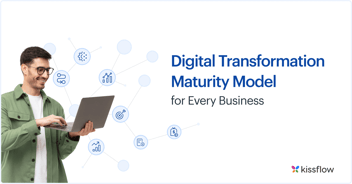
- >
- Digital Transformation >
- Digital Transformation Phases That Every Organization Goes Through
Digital Transformation Phases That Every Organization Goes Through
Team Kissflow
Updated on 16 Apr 2025 • 7 min read
Digital transformation is one of the most important trends for businesses today. When many people think of digital transformation, they think of a clean transition with a clearly defined end. But growing into a digitally transformed business is gradual and there’s really no end state.
Although digital transformation has become obligatory for any business that wants to stay competitive in today’s business world, the process of achieving this isn’t a linear journey. There’s no single formula that fully captures the process or a magic recipe that works for every single organization out there. Even businesses within the same industry, have to go through slightly different journeys when implementing their digital transformation strategy.
The digital transformation journey is in phases. Everyone starts from different points and they have to navigate through different obstacles. However, the goal at the end of the day is to become an organization whose processes are several times as efficient as they used to be before digital transformation-A company positioned to perform better than competitors and deliver an optimized experience to customers.
While the path towards achieving this differs from one company to the other, There are generic phases that apply to every business Users. This article explains the different phases of digital transformation that every organization has to go through to achieve true transformation.
5 phases in the digital transformation lifecycle in digitizing internal operations
The wide-reaching goal of digital transformation is to integrate digital technology into the different aspects of a business in order to deliver improved services and boost competitiveness. However, this simple definition tends to take on a different meaning for each organization.
Still, there are patterns and specific stages that every digitally-transformed organization goes through. It begins with a planning phase, an implementation stage, and a growth phase before maturity is eventually attained.
Phase 1: Planning phase
Your decision to implement a digital transformation strategy for your organization is a lofty aspiration. However, as with any exciting venture, you need a solid plan to achieve anything positive and lasting. For a predominantly traditional business, attempting to transform your business is stepping into the unknown. However, you shouldn’t step into that void without a plan.
What happens at the planning phase of your digital transformation determines what happens in the other stages. The planning phase is where you come up with a strategic long-term plan for integrating digital technology into every part of your business.
This stage is where you determine the processes that need to be digitalized and what new technologies to implement to make your organization smarter and digitally savvy.
It is worth noting that your digital transformation plan has to be unique for your organization. That’s because the digital transformation will always look different from one organization to the other. Usually, what your planning phase will look like depends on your starting point.
For instance, while planning digital transformation for a traditional company would typically begin with identifying manual processes that need to be digitized, it would look remarkably different from that of a digitally native company with the majority of its processes already digitized.
Another major factor that will determine the nature of your digital transformation plan is your objectives. This is one of the most important things to determine early on in your digital transformation journey.
Businesses in the early stages of implementing a digital transformation strategy have to answer questions that help them identify areas in need of transformation. This will determine how they will begin the next phase of the plan which is the implementation stage itself.
Phase 2: Implementing phase
According to a Mckinsey Survey [1], less than 30% of companies that implement digital transformation are successful at it. 84% of respondents to that survey revealed that their digital transformation plan did not lead to a performance improvement or any long-term changes in their organization.
This shows that having a digital transformation plan is only one part of the journey, implementation is just as important.
The questions you have answered about your digital transformation goals in the planning stage sets the stage for the implementation phase of your plan. It also helps you to determine which part of your plan should be prioritized.
The implementation phase is where you put all your plans in motion. A digital transformation plan typically comes with several moving parts. Attempting to implement all of these different parts at once is not practical. Digital transformation plans are best implemented in iterations. While implementation can take any form, the following are some of the essential things to keep in mind when implementing a Digital transformation plan for your organization.
Getting buy-in
Implementing a digital transformation strategy typically begins with getting buy-in from all the stakeholders to be involved in the implementation. This includes everyone from shareholders to top-level executives and most importantly your employees.
Without buy-in from these people, you cannot even begin to implement digital transformation. Everyone needs to understand the need for digital transformation, and its impact on their organization and must be willing to put in the world required to make it happen.
Prioritize
It’s impossible to implement digital transformation all at once for all areas of your business. A more practical plan identifies the high-impact areas where you can begin to implement digital transformation and targets for those first. Bear in mind that digital transformation has to be implemented alongside your regular operations.
You cannot put your business on hold to implement digital transformation. This further adds a layer of complexity to your digital transformation efforts. It is best to break your digital transformation implementation into manageable chunks instead of introducing sporadic and disruptive changes that tend to be overwhelming.
Take stock of your resources
Your human and technical resources are important parts of your digital transformation implementation. Right from the onset, you need to identify these resources and determine how to put them to good use. Implementing digital transformation will require significant investment in personnel training, hiring new hands, and buying new technology.
The most important thing to keep in mind here is to ensure resources are utilized in ways that will be most impactful based on the trajectory of digital transformation for your organization.
Be flexible and adaptable
Flexibility is very important in the implementation phase of your digital transformation plan. Each iteration of your attempt to digitize a crucial process may take anywhere from weeks to months at a time. It is important that you’re adaptable to the changes that will come while still working within the initial scope of your plan.
Phase 3: Growth phase
Setting digital transformation in motion is only the start of a journey. The next phase of the journey is where you learn to experiment, adapt and navigate all the challenges that come with digitizing your organization. This is the growth phase of your digital transformation journey.
This phase is very important because this is where everything tends to fall apart for most organizations. It involves solving multiple problems all at once and as rapidly as possible. The growth phase is also where you identify inefficiencies and areas that require improvement. In some cases, this may also mean adjusting your objectives and charting a new path toward achieving the new goals you have set.
Phase 4: Mature phase
A company can be said to be at the maturity phase of its digital transformation journey if it has a well-established digital transformation roadmap in place and is moving forward in its plans toward implementing this roadmap. Companies at this stage have learned to leverage digital technology to run their business and drive continuous change across their organization from top to bottom.
It is important to note that digital maturity is not absolute. No business is ever truly fully transformed. Instead, Digitally maturing businesses are at a stage of consistent transformation where they continuously adopt new processes, technologies, and strategies in alignment with their set goals.
Rating an organization’s status in this regard often involves tracking the impact of digital transformation on company culture, technology stack, customer service, leadership, and so on. Access to data and insight is necessary to measure performance across each of these areas to measure the success of an organization’s digital transformation efforts.
Phase 5: Optimizing phase
Digital transformation never ends. Digitally mature businesses are not meant to ever stop growing or transforming their processes. Competitors are constantly growing and customer behavior will always change. The volatile nature of digital technology also means the digital landscape is in a constant state of evolution.
In the last few years, there has been an unprecedented adoption of digital technology and it doesn’t seem like it will be slowing down soon. Global spending on digital transformation is projected to hit $2.8 trillion by 2025 [2]. That’s more than double the amount spent by organizations on digital transformation in 2020.
Businesses that win the digital transformation battle need to consistently invest in the optimization phase of their journey. Note that this is not a mindless scramble to adopt every new technology that hits the market
The optimization phase of digital transformation is just as strategic as the other phases. It involves tracking and measuring the trend of digital transformation initiatives, measuring success based on set objectives, and identifying areas where new technology and process changes can benefit your ongoing digital transformation efforts.
Some of the key metrics to track in this regard include adoption performance, Digital ROI, and improvements in customer experience. Optimizing digital transformation is about putting measures in place to improve these metrics
Digital transformation at work ™- Walmart is an example
A good example of how the different phases of digital transformation can play out in a traditional non-digital organization is the case of Walmart, America’s biggest brick-and-mortar retail business. The entry of digitally native eCommerce companies like Amazon into the retail business changed the digital landscape of the industry, conventional businesses in the industry had to adapt or get kicked out by the competition.
For Walmart, the main goal of kickstarting a digital transformation program was to drive superior associate performance, higher customer satisfaction, and stronger financial returns. Walmart’s entry into the digital transformation race began with setting up an eCommerce website that allowed them to start selling goods online too. But that’s only one of several steps.
Walmart had the plan to achieve greater digitalization in nearly all aspects of its business beginning with the supply chain to customer service, marketing sales, and operations. The company’s investment in digitalization would also increase operational efficiency.
Once the goal was set, Walmart started small. Digitizing the supply chain was a top priority. Achieving this helped the company set the stage for implementing an omnichannel digital transformation strategy with a higher chance of success.
In the next phase of the journey, Walmart leveraged cloud technology across its retail landscape. The company put measures in place to leverage the large pool of data generated daily from customer interaction and converted it to actionable insights.
Collaboration with Microsoft for Cloud data services was pivotal to the success of Walmart’s strategy. The company also adopted various tools that would allow internal employees to collaborate productively and automate vital processes. All of these were implemented in different phases and the company has been able to drive real digital change by constructively following this road map.
Wrapping up
We are at an interesting point in the digital transformation revolution, with more and more organizations realizing the inevitability of getting in on the trend. However, knowing that you have to transform your business is not the same as knowing how to do it.
Understanding the different phases of digital transformation as highlighted above and knowing how to take your organization through them successfully will define whether or not you’ll be able to achieve results as far as digital transformation is concerned. For many organizations at the starting line, only time will tell if they’re doing Digital Transformation right.
Kissflow's digital transformation platform can help you leverage the unique opportunities of the digital transformation journey to innovate and grow. You’ll build a strong foundation, minimize risks, make the most of the digital process, and smoothly transition into a digital organization.
Wanna Know how Kissflow Can Accelerate Your Digital Transformation?
Related Articles











